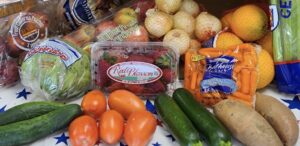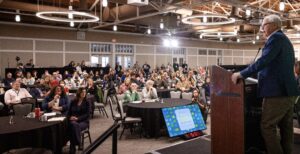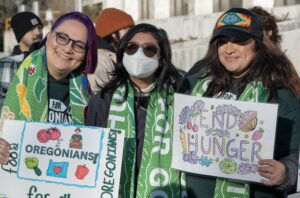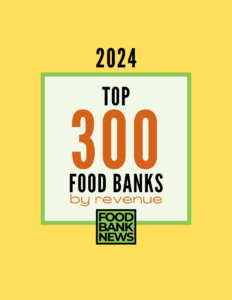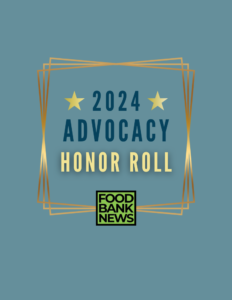When Osvaldo Grimaldo joined Houston Food Bank just over a year ago as its inaugural Civic Engagement Specialist, he had his work cut out for him.
In surveying agency partners and community members on their attitudes toward voting, Grimaldo uncovered a general lack of knowledge and resources. Of the more than 80% of agency partners that expressed interest in participating in civic engagement work, most had no experience or idea about how to start. Of more than 100 neighbors surveyed, many expressed intimidation by the voting process, feelings of being ignored by elected officials and the belief that their vote didn’t matter.
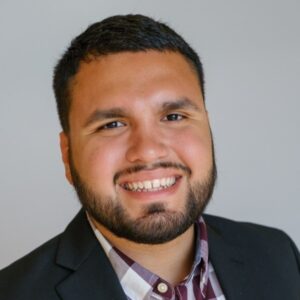
Grimaldo and Houston Food Bank are in the vanguard of efforts by food banks to get out the vote among the populations they serve. Although most food banks are prohibited from supporting individual political campaigns as 501(c)(3) charitable organizations, they are unified in their messaging that the voices and votes of the people they serve matter. They also are pushing the mantra that food banking alone does not solve food insecurity, and that policy is critical in effective hunger relief.
According to JC Dwyer, who previously worked in food banking and now runs a consultancy focused on advocacy and civic engagement, communities served by food banks routinely vote at lower rates than higher-income neighborhoods, making candidates less likely to court those votes and address the needs of those communities.
Nonprofits can play an important role in reversing that cycle, Dwyer said. Voter engagement by trusted community organizations can boost voter turnout by ten percentage points or more, he noted. “If those communities are expected to be places where elected officials can find votes, they’re going to have a stronger incentive to pay attention to those communities, they’re going to have a stronger incentive to spend their political capital in those communities,” Dwyer said.
At Houston Food Bank, Grimaldo’s team developed a “partner-powered approach” aimed at getting agency partners to also serve as “civic hubs.” These hubs receive mini grants from the food bank to become one-stop locations where community members can get not only food but also voting information and help with registration. To protect its 501(c)(3) nonprofit status, the food bank partnered with a local branch of the League of Women Voters to develop co-branded materials.
Houston Food Bank also operates a leader development program at the civic hubs to train volunteers already familiar to the local community. “We want our neighbors to feel comfortable,” Grimaldo said. “Because voting is such a heavy topic, you know, in today’s day and age. We want our neighbors to feel at home.”
Once voter registration closes, Houston Food Bank plans to shift its focus to voter education. It is working with its county elections office to develop a curriculum on voting and will even install ballot machines at partner agency sites so people can practice the physical act of voting as a way of overcoming their fears. Some of the civic hubs have also expressed interest in becoming voting centers, Grimaldo said.
Tapping into the agency network is often the start to this work. “We know that our partners at food pantries, soup kitchens and other food programs are trusted voices in their neighborhood,” said Camerin Mattson, Communications Manager at Greater Chicago Food Depository. “And who better to provide the resources for making sure people know about how to register to vote, when the deadlines are, when the date is, and where there are polling places.”
Greater Chicago Food Depository has been working on voter engagement since the 2020 election. In partnership with local organizations, it has developed online and in-person training programs, dual-lingual materials and other tools so agency partners can educate, register and interact with visitors about voting.
The fundamental part of the work is ensuring people are registered to vote, Mattson said, especially given that many people the food bank serves have been disenfranchised and disengaged from the voting process. But it’s also about making sure people have accurate information about the candidates and other logistics.

At Second Harvest Heartland, where the goal is to cut hunger in Minnesota in half by 2030, raising general awareness about the issue of food insecurity is a primary goal, alongside training and one-on-one engagements with voters. Local advertisements and flyers at farmers markets, community festivals and other events are some of the ways Second Harvest Heartland engages people in conversations about the problems of hunger and food insecurity.
Sometimes, it asks people to pledge to vote with hunger in mind in November. “Just building that mindset, that mentality that this is an issue that people should care about,” said Zach Rodvold, Director of Public Affairs. “First educate people on how bad things are and are getting in our state, and then draw the connection to public policy.”
Part of the food bank’s metric of success is “the number of people in the legislature from any party who have hunger as one of their top priorities,” Rodvold said. Through awareness campaigns, education and engagement with voters, Second Harvest Heartland hopes to create further incentives for officials to take the issue seriously. “Then we are better positioned to cut hunger in half by 2030,” Rodvold said. “We’re not going to charity our way out of hunger.”
Rodvold noted the challenges of venturing into voter engagement. “It takes time to socialize this idea, to make these connections for people on why it’s important, how it impacts our mission, why we’re investing resources in it,” he said.
Questions from agency partners about the legality of the work is another challenge, requiring reassurance that voter engagement and advocacy is safe work. There are also regional differences in voting rules. In Texas, for example, paper requirements and earlier registration deadlines create further barriers and capacity demands.
Despite the challenges, Rodvold is hopeful that more people will see the connection between public policy and hunger relief. He said, “We’re hoping that we can cut through the noise of the election and get people excited about solving one really big and important problem in our community.” – Kathy Ou
Kathy Ou is a reporter and critic based in New York, bred in Southern California and born in Southern China. She is a student at New York University’s Cultural Reporting and Criticism program. Her writings have appeared on Prism, AsAmNews, The Yappie, The Amp and more.
PHOTO, TOP: Ken Ward, IT Specialist at Houston Food Bank, gets behind the food bank’s efforts to get the vote out.
Like what you’re reading?
Support Food Bank News


